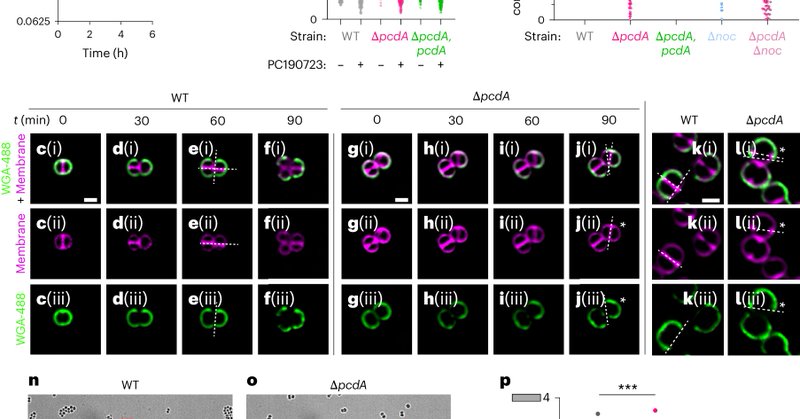
Kumaran Ramamurthi
@RamamurthiLab
Followers
2K
Following
4K
Media
40
Statuses
1K
Sock afficionado and scientist @theNCI @NIH studying protein localization in bacterial cells ( 🟦☁️ @RamamurthiLab) All views are my own.
Bethesda, MD
Joined June 2018
@felixrl_ took on a ~50-yr-old mystery in #Staph aureus cell biology and came out on top! Check out his paper on how #Staphylococcus aureus chooses its cell division plane, how it forms clusters, and why all this matters during infection.
nature.com
Nature Microbiology - PcdA interacts with DivIVA and FtsZ, promoting Z-ring formation and division plane selection in Staphylococcus aureus, which increases virulence in mice and reduces...
2
28
70
RT @EvolvedBiofilm: See our new (data) preprint on the 121 sporulating Bacillales genomes by Lijie Song and @LasseJDNielsen1 et al a @cemis….
0
11
0
RT @jivarahasya: Extracellular Calcineurin-like phosphoesterases foster and signal altruistic behavior in bacteria. This new work with @Ram….
0
10
0
RT @FabriceJPierre: Busy day in the lab! @JoVEJournal is shooting a video on a methods paper that my trainee (@Sarah_Poirier) and I publish….
0
6
0
RT @MohiniB1: Excited to share my postdoctoral work on novel aspects of S. aureus skin infection pathogenesis, out as pre-print. This was s….
0
6
0
RT @jivarahasya: From anti-invader immunity to the cytoskeleton: the tale of McrB proteins.This work with @RamamurthiLab @ProteinVerse sho….
0
21
0
RT @foster_lab: We are very excited to announce our latest work on how MRSA conquers antibiotics. We show that high-level resistance to met….
0
25
0
RT @chienlab: Since we only had a month to post this, we got permission to extend priority review to Nov 15! So send us your applications!….
0
4
0
RT @JWVeening: Checkout @Bevika2 preprint! She used CRISPRi-seq to determine antibiotic-stress signatures, specifically of pneumococci trea….
biorxiv.org
Streptococcus pneumoniae is a human pathogen that has become increasingly resistant to the synthetic fluoroquinolone antibiotics that target bacterial topoisomerases. To identify pathways that are...
0
17
0
RT @rborza_: 🚨 Great alternatives to BioRender are now available!!. 📢 @NIAIDNews offers a collection of public figures and icons for everyo….
0
642
0
RT @BrianKCoombes: Every 6 seconds, someone dies from an antibiotic-resistant infection. Today, on day 242 of the year, over 3.2 million p….
0
59
0
Come join a fun group of bacteriologists @IRPatNIH near DC!.
I am excited to announce several post-doc positions studying gene regulation and cell biology of spirochetes are available in the @NIH Biology of Spirochetes Unit, opening 2025 in Bethesda, MD @NIAIDNews! Join our team and work on the dynamic NIH campus:
0
0
7
RT @DrPhilipAdams: I am excited to announce several post-doc positions studying gene regulation and cell biology of spirochetes are availab….
0
87
0
RT @NatureMicrobiol: 🦠➗OUT NOW - PcdA promotes division plane selection in #Staph by @RamamurthiLab @felixrl_ @braf_phd @ProteinVerse @Aman….
nature.com
Nature Microbiology - PcdA interacts with DivIVA and FtsZ, promoting Z-ring formation and division plane selection in Staphylococcus aureus, which increases virulence in mice and reduces...
0
11
0
A really fun collaborative effort with @braf_phd ,@ProteinVerse , @cytomotive , @MissiakasLab , @jivarahasya.
0
0
4
So, what's the point of this growth pattern? Without PcdA, #Staph fails to grow as clusters and exhibits a defect in the ability to persist in kidney lesions during infection in a mouse model. We speculate that clustered growth defends S. aureus against host immune attacks.
1
0
2
That's right-- it's a(nother) POSITIVE FtsZ placement factor in bacteria (as opposed to the well-studied Min system in E. coli, which restricts FtsZ placement).
1
0
5
Short answer: as the normally spherical #Staph grows, it slightly elongates. The protein DivIVA recognizes these "poles" and localizes there. DivIVA recruits an AAA+ ATPase named "PcdA" (previously of unknown function), which then recruits FtsZ to the correct site.
1
0
0
Daughter cells of the spherical #Staph "remember" the cell division plane that the parent cell used, and divide roughly perpendicular to that plane. This leads to the characteristic grape-cluster-like growth pattern of this bacterium. How in the world does this work???.
1
0
0



